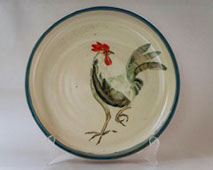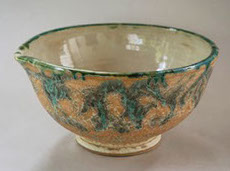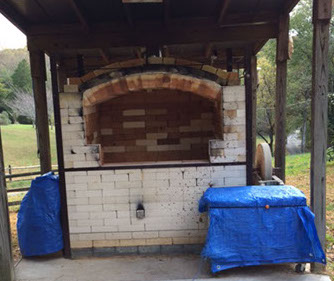Under the Scope
LAURA NICHOLS


Running her family’s ancestral farm in northern Virginia, Laura is surrounded by farm animals and wild life. With a PhD in Anthropological Linguistics, Laura is interested in the relationship between symbols and culture. Her pottery is certainly full of symbols of her farm life.
Paintings of roosters, sheep, heron, owls or frogs are frequent guests on her pots. Her portfolio includes fountains and lamps as well as mugs, cups, bowls and platters. To achieve the softer more fluid effect of her images, she uses a unique technique of painting with an underglaze over the glaze instead of under it.
Laura makes and fires all of her pottery at her studio, “Pig Pen Pottery, “ located on the farm. In addition to two electric kilns, Laura also has a gas kiln. Most studio potters fire in electric kilns, but gas kilns give some unique effects. If you have a gas kiln, a lot of potters will want to be your friend, particularly if you have all of Laura’s firing expertise!!!
In addition to rounding up the goats and sheep, feeding the animals, gathering fresh chicken eggs and figuring out how to put a fat sheep on a diet (she put a dog muzzle on it a few hours a day—and it worked), Laura still finds time to teach pottery classes. She enjoys the students and finds their questions and interests pushing her to new ideas and techniques.
Laura also founded an art organization, Great Falls Studios, 13 years ago and managed it for 11 years. In addition to her over 10 years participation in Scope, she exhibits at the Norfolk Artisans Guild in Norfolk, CT and at Sheffield Pottery in MA as well as at Roots 657 in Leesburg, VA.
For more of Laura’s work, see www.PigPenPottery.com.
KILNS
All kilns consist of chambers with a heat source capable of generating enough heat to bring the clay and glaze to maturity. The amount of heat needed depends on the type of clay and also the glaze.
Electric kilns
In electric kilns, the pottery is heated to a certain temperature using oxygen. The oxygen causes particles in the clay and glaze to oxidize. This is what gives the clay and glaze their color and texture. Because electric kilns use oxygen, firings in these kilns are referred to as “oxidation firings.”
Gas kilns
Gas kilns are a type of “reduction” kiln that is fueled by gas. Other reduction kilns generally are fueled by wood. Unlike firings in electric kilns, fuel is introduced in a reduction firing to reduce the amount of oxygen in the kiln. Fuel needs oxygen to burn. When there is not enough oxygen, the fuel produces hydrogen and carbon monoxide gases that grab any oxygen they can find in the clay or glaze. When these reducing gases take oxygen out of the clay and glaze, they impact the clay surface and glaze color in ways that are different than those obtained in an oxidation firing. Iron and copper oxides are particularly affected by reduction. With oxygen, glazes high in iron oxides are generally reddish brown. In a reduced atmosphere these glazes will be green to blue-green. Conversely, glazes high in copper will be green in oxidation and red to purple in reduction. It is not a simple process. There are many variables, such as atmospheric pressure, wind and placement of the piece in the kiln. There are always surprises.

Laura's Gas Kiln
Scope Gallery
Torpedo Factory Art Center
105 N. Union St.
Ground Floor, Studio 19
Alexandria, Va 22314
Phone: 703-548-6288
Winter 2022 Hours:
11:00 a.m. - 5:30 p.m. Thursday - Sunday
Check the Torpedo Factory website for any changes to the building open hours. www.torpedofactory.org/todays-hours/

